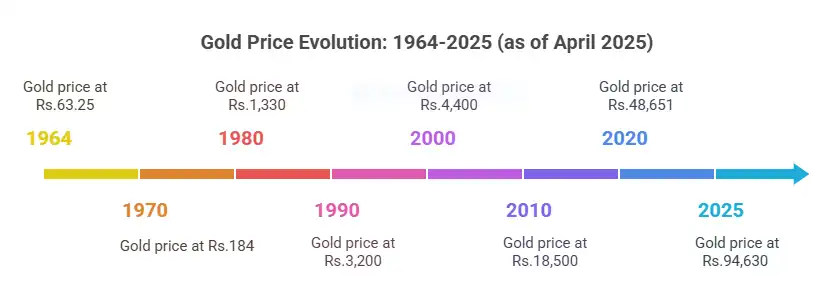
Gold Price History in India: Historical Chart, Trends & Rates
In Indian homes, gold has always been valued highly, whether as jewellery, an investment, or a representation of cultural sentiment. It is a reliable and enduring aspect of Indian life, from weddings and festivals to inheritance and financial crises. But over time, its monetary value has changed significantly.
This article will guide you through the historical price trends of gold in India, the factors that affect these prices, their cultural significance, and current gold investment opportunities.
Gold Rate History in India
The following chart outlines the historical average price of 24K gold (per 10 grams) in India:

Year | Price (24K, per 10g) |
2025 (as of July) | ₹94,630 |
2024 | ₹64,070 |
2023 | ₹65,330 |
2022 | ₹52,670 |
2021 | ₹48,720 |
2020 | ₹48,651 |
2015 | ₹26,343 |
2010 | ₹18,500 |
2000 | ₹4,400 |
1990 | ₹3,200 |
1980 | ₹1,330 |
1970 | ₹184 |
1964 | ₹63.25 |
Significance of Gold in Indian Culture
Gold extends beyond its monetary value in Indian society. Its relevance is embedded in religious observances, family traditions, and social customs. Key cultural roles of gold include:
- Religious Beliefs: Gold is considered sacred and is donated generously to temples and used in rituals.
- Family Legacy: Jewellery often becomes heirlooms passed down generations.
- Symbol of Wealth & Status: Gifting or owning gold is a sign of prosperity.
- Financial Backup: In emergencies, gold is often the first asset families turn to.
Gold Rate History in India: Last 5 Years
A closer examination of the last five years reveals the economic forces behind recent price movements:
- 2020: Prices surged due to global uncertainty and COVID-19 panic, peaking at ~₹48,651.
- 2021–2022: Moderate correction as economies started stabilizing.
- 2023–2024: Gradual increase influenced by geopolitical tensions (Russia-Ukraine), high inflation, and fluctuating USD.
- 2025 (so far): Reaching all-time highs (~₹94,630), reflecting continued global uncertainty and strong investor demand.
Gold Prices in India: Before & After Independence
Before 1947
Gold acted more as a currency and reserve asset. Prices were relatively stable due to less international volatility.
Post-Independence
From ₹88 in 1947 to nearly ₹95,000 today, India has witnessed dramatic gold price growth driven by wars (1962 Indo-China), economic reforms, global oil crises, inflation, and most recently—international conflict and currency weakness.
Factors That Influence Gold Prices in India
Gold prices in India are influenced by both domestic and international factors, including:
USD to INR Exchange Rate
- Since India imports the majority of its gold, the exchange rate between the US dollar and the Indian rupee plays a critical role. A weaker rupee increases import costs, making gold more expensive for Indian consumers.
International Gold Prices
- Global trends have a direct influence on domestic prices. International benchmarks, such as the London Bullion Market rate, set the tone for local pricing, especially since India is one of the largest gold importers in the world.
Inflation and Interest Rates
- Gold is often seen as a hedge against inflation. When inflation rises or when interest rates fall, demand for gold typically increases. Lower interest rates make non-yielding assets like gold more attractive.
Government Policies and Duties
- Changes in import duties, Goods and Services Tax (GST), or central bank regulations can raise or reduce the retail price of gold. Policy announcements around taxation and trade restrictions can impact demand and pricing significantly.
Seasonal and Cultural Demand
- India’s festive and wedding seasons create sharp spikes in gold purchases. Periods such as Diwali, Akshaya Tritiya, and the wedding season often witness high demand, pushing prices upward.
Why is Gold Getting More Expensive Over Time?
Several structural and economic factors contribute to the long-term rise in gold prices:
Limited Supply, Growing Demand
- While the global demand for gold continues to rise, especially from investors and central banks, the supply remains relatively fixed. This imbalance naturally pushes prices upward.
A Safe Bet in Uncertain Times
- Gold has always been seen as a reliable store of value, especially during economic downturns or geopolitical tension. When markets turn volatile, people turn to gold for financial security.
Currency Value Is Falling
- As inflation rises and currencies like the rupee or dollar weaken, gold tends to hold its value better. This makes it a preferred choice for those looking to preserve their purchasing power.
Digital Platforms Have Opened Up Access
- With options like Sovereign Gold Bonds (SGBs), Exchange Traded Funds (ETFs), and mobile investment apps, more people can invest in gold than ever before. This wider accessibility has contributed to increased demand.
What are the Best Gold Investment Options in India?
For individuals seeking alternatives to physical gold, several regulated and tax-efficient options are available:
Sovereign Gold Bonds (SGBs)
- Issued by the Reserve Bank of India, SGBs offer annual interest and come with a major tax benefit. If held till maturity, there’s no capital gains tax.
Gold ETFs
- These are traded on stock exchanges and follow gold’s market price. You can buy or sell units just like stocks, making them a flexible option.
Digital Gold
- Offered through fintech platforms, digital gold lets you invest in small amounts and redeem or sell anytime. It’s easy to access, especially for first-time investors.
Gold Mutual Funds
- These funds invest in gold ETFs and give you indirect exposure to gold’s performance, all while being professionally managed.
Gold Rate Future Prediction
While predictions can’t be guaranteed, here’s a speculative view based on global economic forecasts:
Year | Predicted Price (24K/10g) |
2025 | ₹94,630 (current) |
2026 | ₹1,02,000 |
2027 | ₹1,09,500 |
2028 | ₹1,17,400 |
2029 | ₹1,25,800 |
2030 | ₹1,34,900 |
Note: Market analysts anticipate steady growth unless major global economic stabilizers reduce uncertainty and inflation risk.
Things to Keep in Mind While Buying Gold in India
Prospective buyers should take the following precautions:
Verify Purity
- Always ensure the gold is BIS-hallmarked. This is the most reliable certification of purity and protects you from fraudulent or substandard products.
Understand Making Charges
- Making charges can significantly increase the final price, especially for designer or customised jewellery. Clarify the percentage and whether it is refundable during resale.
Refer to Authorised Price Sources
- Check the real-time gold rate from credible platforms such as the Indian Bullion and Jewellers Association (IBJA), Multi Commodity Exchange (MCX), or official RBI updates.
Avoid Buying During Peak Seasons
- Gold prices often rise during festivals and wedding seasons due to high demand. If your purchase is not urgent, consider waiting for a price correction.
Clarify Buy-Back and Exchange Policies
- If purchasing from a jeweller, review their buy-back terms, resale conditions, and whether the policy is written or verbal. This is crucial for long-term value recovery.
Conclusion
In India, gold is more than just a commodity; it is a symbol of custom, reliability, and long-term economic viability. It is crucial to comprehend its historical background and the factors that influence its value as prices hit previously unheard-of heights in 2025.
Make sure your gold strategy is in line with your financial objectives, whether you decide to use digital gold, ETFs, or Sovereign Bonds.
Related Articles:
1. RBI’s New Gold Loan Rules 2025
2. How to Calculate Making Charges on Gold?
3. Best Days to Buy Gold in 2025
4. Countries With Largest Gold Reserves in The World
5. How Much Gold is allowed from Dubai to India?
Frequently Asked Questions



